#Cambodia. A Buddhist monastery built in the late 12th and early 13th Centuries
Text
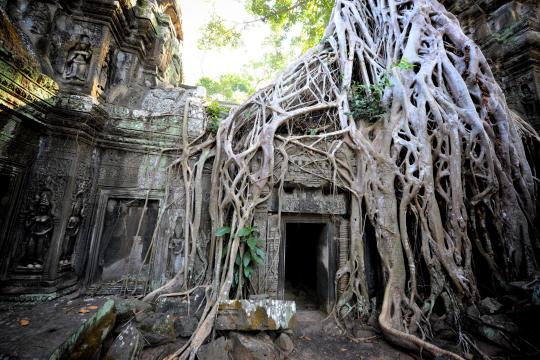
#Ta Prohm Temple#Siem Reap#Cambodia. A Buddhist monastery built in the late 12th and early 13th Centuries#in the Banyon style.Fig banyan and kapok trees have taken over
1 note
·
View note
Text
Ta Prohm



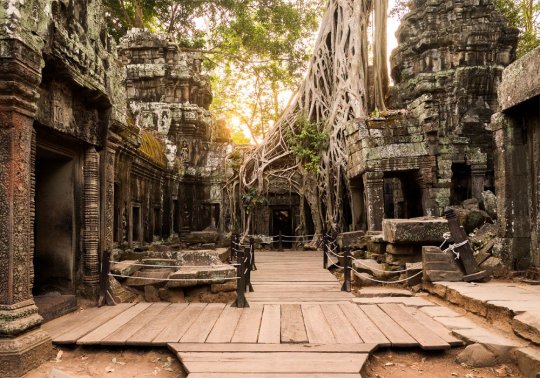
Ta Prohm is the modern name for the temple at Angkor. There are 72 major temples in the Angkor area, located in Cambodia in the Siem Reap province. The Ta Prohm Temple was built in the late 12th and early 13th centuries. The temple became a Mahayana Buddhist monastery and university, which was founded by the Khmer King, Jayavarman VII, who dedicated Ta Prohm to his mother. Ta Prohm is a traditional Khmer structure consisting of a series of gradually smaller enclosures, with the center tower connecting the smaller towers through passageways. The site was home to more than 12,500 people in the late 12th century, with a population of 800,000 in the surrounding villages. The temple was modified after King Jayavarman VII’s death and later modified by Hindu and Theravada Buddhist kings in accordance with their religious beliefs. The temple was abandoned after the fall of the Khmer Empire in the 17th century. Restoration to conserve the temples of Angkor began in the early 21st century, but it was decided that Ta Prohm would be left in its ruined state. The jungle surrounding the temple merged with the ruins, giving it a new overall appeal to the tourists who frequent the temple. Although the ruins are bound by massive roots from the fig, silk-cotton, and kapok trees, the area was stabilized to make the temple accessible to tourists, which was necessary since Ta Prohm is Angkor’s most visited temple. Ta Prohm was inscribed by UNESCO and placed on the World Heritage list in 1992. The temple includes 260 statues of gods, 39 towers with pinnacles, and 566 different residences. Lara Croft: Tomb Raider was filmed there.
12 notes
·
View notes
Text
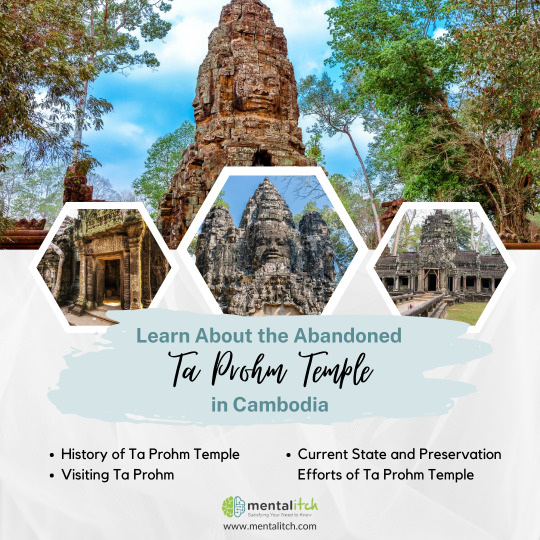
Learn About the Abandoned Ta Prohm Temple in Cambodia
Located in the vast and majestic Angkor archaeological complex in Cambodia, lies the abandoned Ta Prohm Temple, a sight that evokes a sense of awe and wonder. This temple, built in the late 12th and early 13th century, was once a flourishing Buddhist monastery and educational institution. However, through centuries of neglect and natural forces, it was left to be consumed by the surrounding jungle, giving it a hauntingly beautiful appearance.
https://mentalitch.com/learn-about-the-abandoned-ta-prohm-temple-in-cambodia/
0 notes
Photo
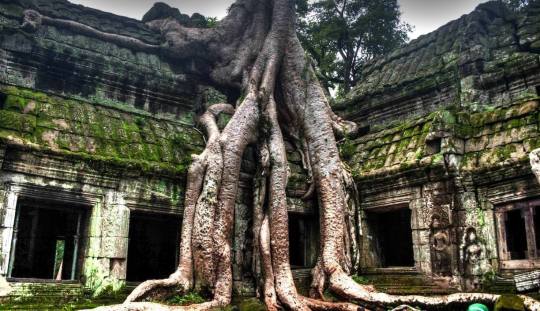
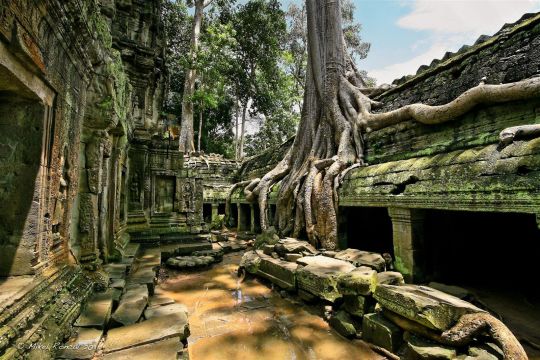
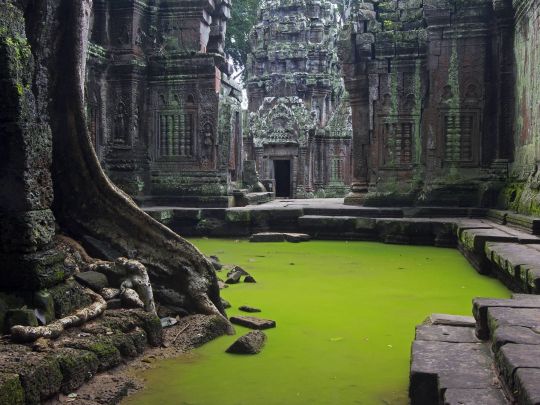
Ta Prohm Temple, Angkor, Siem Reap Province, Cambodia
“Ta Prohm (Khmer: ប្រាសាទតាព្រហ្ម, "Ancestor Brahma") is the modern name of the temple in Siem Reap, Cambodia, built in the Bayon style largely in the late 12th and early 13th centuries and originally called Rajavihara (Khmer: រាជវិហារ, "royal monastery"). Located approximately one kilometre east of Angkor Thom and on the southern edge of the East Baray, it was founded by the Khmer King Jayavarman VII[1]:125[2]:388 as a Mahayana Buddhist monastery and university. Unlike most Angkorian temples, Ta Prohm is in much the same condition in which it was found: the photogenic and atmospheric combination of trees growing out of the ruins and the jungle surroundings have made it one of Angkor's most popular temples” - Wiki
#Ta Prohm#temple#university#ancient#buddhism#monastery#mystery school#Mahayana#beauty#sacred geometry#angkortemples#angkor#brahma#ta prohm temple#fav#tree of life
356 notes
·
View notes
Text
January 20, 2020
Today we started our day visiting the The Tuol Sleng Genocide Museum (Khmer: សារមន្ទីរឧក្រិដ្ឋកម្មប្រល័យពូជសាសន៍ទួលស្លែង). It is a museum in Phnom Penh, the capital of Cambodia, chronicling the Cambodian genocide. The site is a former secondary school which was used as Security Prison 21 (S-21) by the Khmer Rouge regime from its rise to power in 1975 to its fall in 1979. From 1976 to 1979, an estimated 20,000 people were imprisoned at Tuol Sleng (the real number is unknown). Tuol Sleng (Khmer: ទួលស្លែង Khmer pronunciation: [tuəl slaeŋ]) means "Hill of the Poisonous Trees" or "Strychnine Hill". Tuol Sleng was just one of at least 150 torture and execution centers established by the Khmer Rouge,[2] though other sources put the figure at 196 prison centers. On July 26, 2010, the Extraordinary Chambers in the Courts of Cambodia convicted the chief of Tuol Sleng Prison, Kang Kek Iew, (alias Duch) for crimes against humanity and grave breaches of the 1949 Geneva Conventions and sentenced him to life imprisonment. Formerly the Tuol Svay Pray High School,[4] named after a royal ancestor of King Norodom Sihanouk, the five buildings of the complex were converted in March/April 1976 into a prison and interrogation center. Before other buildings in town were used already as prison S-21. The Khmer Rouge renamed the complex "Security Prison 21" (S-21) and construction began to adapt the prison to the inmates: the buildings were enclosed in electrified barbed wire, the classrooms converted into tiny prison and torture chambers, and all windows were covered with iron bars and barbed wire to prevent escapes and suicides.
From 1976 to 1979, an estimated 20,000 people were imprisoned at Tuol Sleng (the real number is unknown). At any one time, the prison held between 1,000–1,500 prisoners. They were repeatedly tortured and coerced into naming family members and close associates, who were in turn arrested, tortured and killed. In the early months of S-21's existence, most of the victims were from the previous Lon Nol regime and included soldiers, government officials, as well as academics, doctors, teachers, students, factory workers, monks, engineers, etc. Later, the party leadership's paranoia turned on its own ranks and purges throughout the country saw thousands of party activists and their families brought to Tuol Sleng and murdered.[4] Those arrested included some of the highest ranking communist politicians such as Khoy Thoun, Vorn Vet and Hu Nim. Although the official reason for their arrest was "espionage", these men may have been viewed by Khmer Rouge leader Pol Pot as potential leaders of a coup against him. Prisoners' families were sometimes brought en masse to be interrogated and later executed at the Choeung Ek extermination center.
In 1979, the prison was uncovered by the invading Vietnamese army. In 1979/80, the prison was reopened by the government of the People's Republic of Kampuchea as a historical museum memorializing the actions of the Khmer Rouge regime.
Upon arrival at the prison, prisoners were photographed and required to give detailed autobiographies, beginning with their childhood and ending with their arrest. After that, they were forced to strip to their underwear, and their possessions were confiscated. The prisoners were then taken to their cells. Those taken to the smaller cells were shackled to the walls or the concrete floor. Those who were held in the large mass cells were collectively shackled to long pieces of iron bar. The shackles were fixed to alternating bars; the prisoners slept with their heads in opposite directions. They slept on the floor without mats, mosquito nets, or blankets. They were forbidden to talk to each other.[4]
The day in the prison began at 4:30 a.m. when prisoners were ordered to strip for inspection. The guards checked to see if the shackles were loose or if the prisoners had hidden objects they could use to commit suicide. Over the years, several prisoners managed to kill themselves, so the guards were very careful in checking the shackles and cells. The prisoners received four small spoonfuls of rice porridge and watery soup of leaves twice a day. Drinking water without asking the guards for permission resulted in serious beatings. The inmates were hosed down every four days.[4]
The prison had very strict regulations, and severe beatings were inflicted upon any prisoner who tried to disobey. Almost every action had to be approved by one of the prison's guards. They were sometimes forced to eat human feces and drink human urine.[5] The unhygienic living conditions in the prison caused skin diseases, lice, rashes, ringworm and other ailments. The prison's medical staff were untrained and offered treatment only to sustain prisoners' lives after they had been injured during interrogation. When prisoners were taken from one place to another for interrogation, they were blindfolded. Guards and prisoners were not allowed to converse. Moreover, within the prison, people who were in different groups were not allowed to have contact with one another. Most prisoners at S-21 were held there for two to three months. However, several high-ranking Khmer Rouge cadres were held longer. Within two or three days after they were brought to S-21, all prisoners were taken for interrogation.[4] The torture system at Tuol Sleng was designed to make prisoners confess to whatever crimes they were charged with by their captors. Prisoners were routinely beaten and tortured with electric shocks, searing hot metal instruments and hanging, as well as through the use of various other devices. Some prisoners were cut with knives or suffocated with plastic bags. Other methods for generating confessions included pulling out fingernails while pouring alcohol on the wounds, holding prisoners' heads under water, and the use of the waterboarding technique. Women were sometimes raped by the interrogators, even though sexual abuse was against Democratic Kampuchea (DK) policy. The perpetrators who were found out were executed.[4] Although many prisoners died from this kind of abuse, killing them outright was discouraged, since the Khmer Rouge needed their confessions. The "Medical Unit" at Tuol Sleng, however, did kill at least 100 prisoners by bleeding them to death.[6] It is proven that medical experiments were performed on certain prisoners. There is clear evidence that patients in Cambodia were sliced open and had organs removed with no anesthetic.[7][8] In addition, there is also some evidence that inmates were drained of blood in order to study how long they would survive.[9][10]
In their confessions, the prisoners were asked to describe their personal background. If they were party members, they had to say when they joined the revolution and describe their work assignments in DK. Then the prisoners would relate their supposed treasonous activities in chronological order. The third section of the confession text described prisoners' thwarted conspiracies and supposed treasonous conversations. At the end, the confessions would list a string of traitors who were the prisoners' friends, colleagues, or acquaintances. Some lists contained over a hundred names. People whose names were in the confession list were often called in for interrogation.[4]
Typical confessions ran into thousands of words in which the prisoner would interweave true events in their lives with imaginary accounts of their espionage activities for the CIA, the KGB, or Vietnam. Physical torture was combined with sleep deprivation and deliberate neglect of the prisoners. The torture implements are on display in the museum. It is believed that the vast majority of prisoners were innocent of the charges against them and that the torture produced false confessions. Not all prisoners were tortured.
For the first year of S-21's existence, corpses were buried near the prison. However, by the end of 1976, cadres ran out of burial spaces, the prisoner and family members were taken to the Boeung Choeung Ek ("Crow's Feet Pond") extermination centre, fifteen kilometers from Phnom Penh.[11] There, they were killed by a group of teenagers led by a Comrade Teng[11] being battered with iron bars, pickaxes, machetes and many other makeshift weapons owing to the scarcity, and subsequent price of ammunition. After the prisoners were executed, the soldiers who had accompanied them from S-21 buried them in graves that held as few as 6 and as many as 100 bodies.
This was another very somber place with such a terrible history. It was very hard to see and learn about the stories attached to this place. There were two survivors of the prison there today which we met and learned about what happened to them. The only reason they are still alive is that one of the gentlemen was able to repair typewriters, which they used in the prison, and the other gentleman was an artist who painted flattering pictures of Pol Pot. They were still alive when the Vietnamese liberated the prison.
After leaving the museum, we got on our bikes and rode 25 kilometers through the countryside of Phnom Penh. The countryside is littered. Our tour guide explained that this is because the older generation for the most part is not educated well and they do not understand that all the trash and plastic is harming the environment. He said the younger generation here are very worried about the consequences.
Next we went to Ta Prohm (Khmer: ប្រាសាទតាព្រហ្ម, "Ancestor Brahma") Temple. It is the modern name of the temple at Angkor, Siem Reap Province, Cambodia, built in the Bayon style largely in the late 12th and early 13th centuries and originally called Rajavihara (Khmer: រាជវិហារ, "royal monastery"). Located approximately one kilometre east of Angkor Thom and on the southern edge of the East Baray, it was founded by the Khmer King Jayavarman VII[1]:125[2]:388 as a Mahayana Buddhist monastery and university. Unlike most Angkorian temples, Ta Prohm is in much the same condition in which it was found: the photogenic and atmospheric combination of trees growing out of the ruins and the jungle surroundings have made it one of Angkor's most popular temples with visitors. UNESCO inscribed Ta Prohm on the World Heritage List in 1992. Today, it is one of the most visited complexes in Cambodia’s Angkor region. The conservation and restoration of Ta Prohm is a partnership project of the Archaeological Survey of India and the APSARA (Authority for the Protection and Management of Angkor and the Region of Siem Reap).
Next we had lunch out on an over the water hut on Tonle Bati Lake. It is a small lake about 30 km south of Phnom Penh, the capital of Cambodia. It is a popular weekend destination for the local population. It is also a popular fishing spot for both tourists and people who live locally. The women who owned the hut made lunch for us and we relaxed along the water with a much welcomed cool breeze blowing over us.
Our next stop was The Killing Fields, one of the many locations where the Khmer Rouge sent prisoners for immediate death. The Killing Fields (Khmer: វាលពិឃាត, Khmer pronunciation: [ʋiəl pikʰiət]) are a number of sites in Cambodia where collectively more than a million people were killed and buried by the Khmer Rouge regime (the Communist Party of Kampuchea) during its rule of the country from 1975 to 1979, immediately after the end of the Cambodian Civil War (1970–1975). The mass killings are widely regarded as part of a broad state-sponsored genocide (the Cambodian genocide).
Analysis of 20,000 mass grave sites by the DC-Cam Mapping Program and Yale University indicates at least 1,386,734 victims of execution. Estimates of the total deaths resulting from Khmer Rouge policies, including death from disease and starvation, range from 1.7 to 2.5 million out of a 1975 population of roughly 8 million. In 1979, Vietnam invaded Democratic Kampuchea and toppled the Khmer Rouge regime; viewed as ending the genocide.
The Cambodian journalist Dith Pran coined the term "killing fields" after his escape from the regime.
The Khmer Rouge regime arrested and eventually executed almost everyone suspected of connections with the former government or with foreign governments, as well as professionals and intellectuals. Ethnic Vietnamese, ethnic Thai, ethnic Chinese, ethnic Cham, Cambodian Christians, and the Buddhist monkhood were the demographic targets of persecution. As a result, Pol Pot has been described as "a genocidal tyrant." Martin Shaw described the Cambodian genocide as "the purest genocide of the Cold War era."
Ben Kiernan estimates that about 1.7 million people were killed.[6] Researcher Craig Etcheson of the Documentation Center of Cambodia suggests that the death toll was between 2 and 2.5 million, with a "most likely" figure of 2.2 million. After 5 years of researching some 20,000 grave sites, he concludes that "these mass graves contain the remains of 1,386,734 victims of execution."[7] A UN investigation reported 2–3 million dead, while UNICEF estimated 3 million had been killed.[8] Demographic analysis by Patrick Heuveline suggests that between 1.17 and 3.42 million Cambodians were killed, while Marek Sliwinski suggests that 1.8 million is a conservative figure. Even the Khmer Rouge acknowledged that 2 million had been killed—though they attributed those deaths to a subsequent Vietnamese invasion. By late 1979, UN and Red Cross officials were warning that another 2.25 million Cambodians faced death by starvation due to "the near destruction of Cambodian society under the regime of ousted Prime Minister Pol Pot", who were saved by international aid after the Vietnamese invasion.
Another very sad place to see, but very important information to understand.
Our tour guide and driver dropped us back at our hotel. It was an interesting day for us. All of this happened when we were teenagers and it is so awful to think that it just wasn’t that long ago, and we just never seem to learn lessons from these atrocities.
2 notes
·
View notes
Photo

Most visited temple - Prasat Ta Prohm - The Ancestor Brahma, Jungle Temple in Cambodia 😊📸🙏🇰🇭 Greetings and have a great day all. 🤗 Save, Share and Tag this pic. 💾 I love to hear your comments. ✒ ~~~ Ta Prohm (Khmer: ប្រាសាទតាព្រហ្ម, "Ancestor Brahma") is the modern name of the temple in Siem Reap, Cambodia, built in the Bayon style largely in the late 12th and early 13th centuries and originally called Rajavihara (Khmer: រាជវិហារ, "royal monastery"). Located approximately one kilometre east of Angkor Thom and on the southern edge of the East Baray, it was founded by the Khmer King Jayavarman VII as a Mahayana Buddhist monastery and university. Unlike most Angkorian temples, Ta Prohm is in much the same condition in which it was found: the photogenic and atmospheric combination of trees growing out of the ruins and the jungle surroundings have made it one of Angkor's most popular temples with visitors. UNESCO inscribed Ta Prohm on the World Heritage List in 1992. Today, it is one of the most visited complexes in Cambodia’s Angkor region. The conservation and restoration of Ta Prohm is a partnership project of the Archaeological Survey of India and the APSARA (Authority for the Protection and Management of Angkor and the Region of Siem Reap). . . #asianwanderlust #discoverasia #asiatour #asiatravel #loveasia #seasia #seasiatravel #southeastasiatravel #southeastasiatrip #travelinasia #travelsoutheastasia #visitseasia #visitasia #beautifulcambodia #bestofcambodia #cambodge #cambodiaphotos #cambodiatourism #cambodiatravel #cambodiatrip #cambodia🇰🇭 #camboya #explorecambodia #ig_cambodia #igerscambodia #kambodscha #kingdomofwonder #travelcambodia #visitcambodia #worldwithoutborders (at Ta Prohm) https://www.instagram.com/p/CSSK5Susv3R/?utm_medium=tumblr
#asianwanderlust#discoverasia#asiatour#asiatravel#loveasia#seasia#seasiatravel#southeastasiatravel#southeastasiatrip#travelinasia#travelsoutheastasia#visitseasia#visitasia#beautifulcambodia#bestofcambodia#cambodge#cambodiaphotos#cambodiatourism#cambodiatravel#cambodiatrip#cambodia🇰🇭#camboya#explorecambodia#ig_cambodia#igerscambodia#kambodscha#kingdomofwonder#travelcambodia#visitcambodia#worldwithoutborders
0 notes
Photo

Siem Reap K - Ta Prohm 42 by Daniel Mennerich Ta Prohm (pronunciation: prasat taprohm) is the modern name of the temple at Angkor, Siem Reap Province, Cambodia, built in the Bayon style largely in the late 12th and early 13th centuries and originally called Rajavihara (in Khmer: រាជវិហារ). Located approximately one kilometre east of Angkor Thom and on the southern edge of the East Baray, it was founded by the Khmer King Jayavarman VII:125]:388 as a Mahayana Buddhist monastery and university. Unlike most Angkorian temples, Ta Prohm is in much the same condition in which it was found: the photogenic and atmospheric combination of trees growing out of the ruins and the jungle surroundings have made it one of Angkor's most popular temples with visitors. UNESCO inscribed Ta Prohm on the World Heritage List in 1992. Today, it is one of the most visited complexes in Cambodia’s Angkor region. The conservation and restoration of Ta Prohm is a partnership project of the Archaeological Survey of India and the APSARA (Authority for the Protection and Management of Angkor and the Region of Siem Reap). https://flic.kr/p/23oMd2X
0 notes
Text
Prohm (Khmer: ប្រាសាទតាព្រហ្ម, "Ancestor Brahma") is the modern name of the temple in Siem Reap, Cambodia, built in the Bayon style largely in the late 12th and early 13th centuries and originally called Rajavihara (Khmer: រាជវិហារ, "royal monastery"). Located approximately one kilometre east of Angkor Thom and on the southern edge of the East Baray, it was founded by the Khmer King Jayavarman VII:125:388 as a Mahayana Buddhist monastery and university. Unlike most Angkorian temples, Ta Prohm is in much the same condition in which it was found: the photogenic and atmospheric combination of trees growing out of the ruins and the jungle surroundings have made it one of Angkor's most popular temples with visitors. UNESCO inscribed Ta Prohm on the World Heritage List in 1992.
#cambodiaholiday. #CambodiaTrip. #Tapromtemple. #angkorsmartydriver. #MrSmarty. #transportationservices #PrivateTaxi.
https://www.tripadvisor.com/Attraction_Review-g297390-d7710722-Reviews-Angkor_Smarty_Driver_Day_Tours-Siem_Reap_Siem_Reap_Province.html
https://babybatmantuktukdriv.wixsite.com/angkor-smarty-driver
Whatsapp : +85517232934.
Line ID : siemreapcambodiataxi.
WeChat ID: AngkorSmartyDriver
Telegram: @AngkorSmartyDriver
Viber: +85517232934
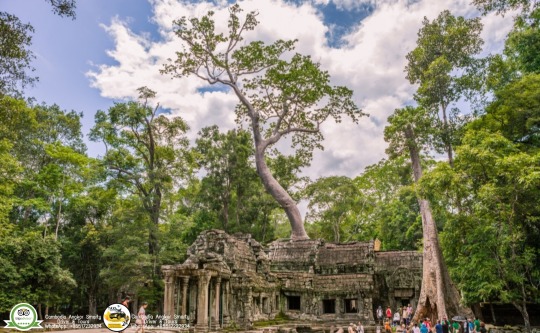


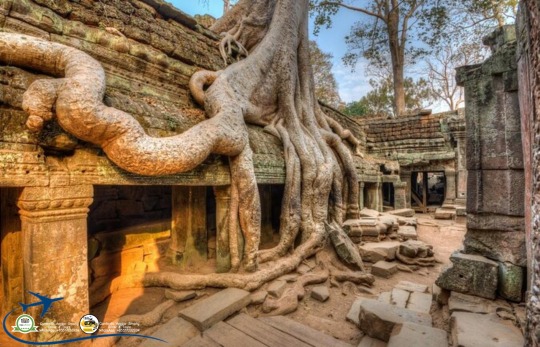

3 notes
·
View notes
Photo

Perhaps one of the most popular of Angkor's temples, Ta Prohm was built in the Bayon style largely in the late 12th and early 13th centuries. Originally called Rajavihara, it was founded by the Khmer King Jayavarman as a Mahayana Buddhist monastery and university. After the fall of the Khmer Empire in the 15th century, and after centuries of neglect when the restoration the temples of Angkor began in the early 21st century, this temple was left mostly as is, because it had best merged with the jungle, but not yet to the point of becoming a part of it. This is why this temple has been capturing the imagination of tourists. It was also popularized by the Anjolina Jolie starer, Tomb raider. The movie uses this temple as a backdrop for some of it's key scenes. I was really interested to know that Archaeological survey of India has played a key role in restoring a lot of these Angkor temples and you can see lot of information on this available in these temple sites. So while ASI is the modern link of India to the Angkor Wat, which is also the world’s largest religious complex, there are some references to a historical connection too. According to some legends a Pallava king from South India, traveled to Cambodia and after marrying a Cambodian princess became king of Cambodia. Suryavarman II who was one of the great rulers of the Khmer Empire, started building this temple complex. The heavy Indian influence on the temple architecture is quite apparent. The Angkor Wat was one of the earlier temples made in this temple complex, was dedicated to lord Vishnu. As the subsequent generations of the Khmer ruler turned to Buddhism, the architecture and the portrayals turned more Buddhist, as it is evident in the temple of Bayon, which has different faces of Buddha. . . 📷@traveltapri . . #indianphotography #indianphoto #indianphotosociety #shutterhubindia #mypixeldiary #_coi #traveltapri #canonindia #yourshotindia #photographers_of_india #indiaclicks #indiaphotosociety #_hpics #photographersofindia #dslrofficial #click_india_click #photofie #indianshutterbugs #indiapictures #picturesofindia #oph #focusontheweelend #pixelpeeper #travelphotography #indiapictures (at Ta Prohm , Angkor Wat Cambodia) https://www.instagram.com/p/BrQKdaBAxsY/?utm_source=ig_tumblr_share&igshid=bbq3tuk1crq0
#indianphotography#indianphoto#indianphotosociety#shutterhubindia#mypixeldiary#_coi#traveltapri#canonindia#yourshotindia#photographers_of_india#indiaclicks#indiaphotosociety#_hpics#photographersofindia#dslrofficial#click_india_click#photofie#indianshutterbugs#indiapictures#picturesofindia#oph#focusontheweelend#pixelpeeper#travelphotography
0 notes
Photo

The reflection of the sun made a nice light dome above the dieties. This looks pretty holy 🙏🏽❤️🇰🇭 • This is Ta Prohm (Khmer: ប្រាសាទតាព្រហ្ម, pronunciation: prasat taprohm) is the modern name of the temple at Angkor, Siem Reap Province, Cambodia, built in the Bayon style largely in the late 12th and early 13th centuries and originally called Rajavihara. It was founded by the Khmer King Jayavarman as a Mahayana Buddhist monastery and university. Unlike most Angkorian temples, Ta Prohm is in much the same condition in which it was found: the photogenic and atmospheric combination of trees growing out of the ruins and the jungle surroundings have made it one of Angkor's most popular temples with visitors. UNESCO inscribed Ta Prohm on the World Heritage List in 1992. Today, it is one of the most visited complexes in Cambodia’s Angkor region. • #cambodia #siemreap #itshotincambodia #cambodiaheat #awayfromhome #aroundtheworld #edücation #worldtravelers #travelingisliving #asia #southeastasia #asiatrip2018 #canyougivemeaminute #tropicalcambodia #welcometocambodia #hellofromcambodia #ontheothersideoftheworld #siemreapcambodia #taprohmtemple #taprohm #taprohmwat #taprohmangkor #pubstreetsiemreap #pubstreetcambodia #mahayanatemple #worldheritagesite #rajavihara #cambodiaisawesome #holysite #i❤️cambodia (at Ta Prohm)
#hellofromcambodia#travelingisliving#tropicalcambodia#welcometocambodia#taprohmangkor#mahayanatemple#edücation#taprohmwat#itshotincambodia#cambodia#awayfromhome#pubstreetsiemreap#holysite#i❤️cambodia#asiatrip2018#southeastasia#siemreapcambodia#taprohmtemple#taprohm#siemreap#rajavihara#canyougivemeaminute#worldtravelers#cambodiaisawesome#aroundtheworld#ontheothersideoftheworld#pubstreetcambodia#asia#worldheritagesite#cambodiaheat
0 notes
Photo
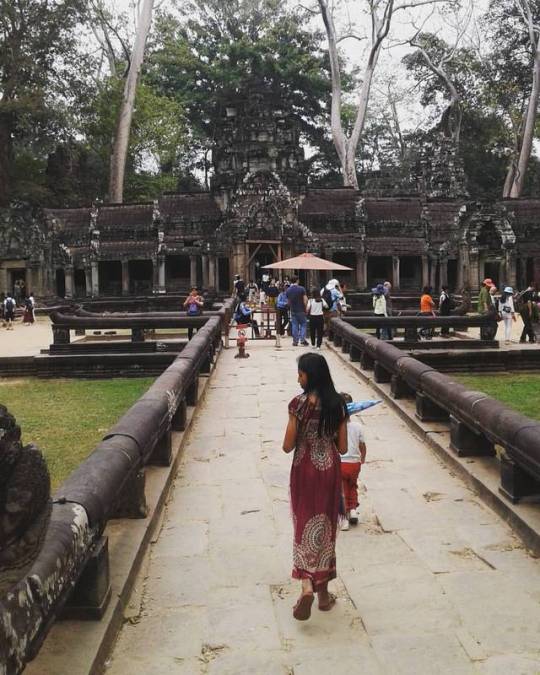
Ta Prohm (Khmer: ប្រាសាទតាព្រហ្ម, pronunciation: prasat taprohm) is the modern name of the temple at Angkor, Siem Reap Province, Cambodia, built in the Bayon style largely in the late 12th and early 13th centuries and originally called Rajavihara (in Khmer: រាជវិហារ). Located approximately one kilometre east of Angkor Thom and on the southern edge of the East Baray, it was founded by the Khmer King Jayavarman VII[1]:125[2]:388 as a Mahayana Buddhist monastery and university. Unlike most Angkorian temples, Ta Prohm is in much the same condition in which it was found: the photogenic and atmospheric combination of trees growing out of the ruins and the jungle surroundings have made it one of Angkor's most popular temples with visitors. UNESCO inscribed Ta Prohm on the World Heritage List in 1992. Today, it is one of the most visited complexes in Cambodia’s Angkor region. The conservation and restoration of Ta Prohm is a partnership project of the Archaeological Survey of India and the APSARA (Authority for the Protection and Management of Angkor and the Region of Siem Reap).[3 (at Ta Prohm)
0 notes
Photo
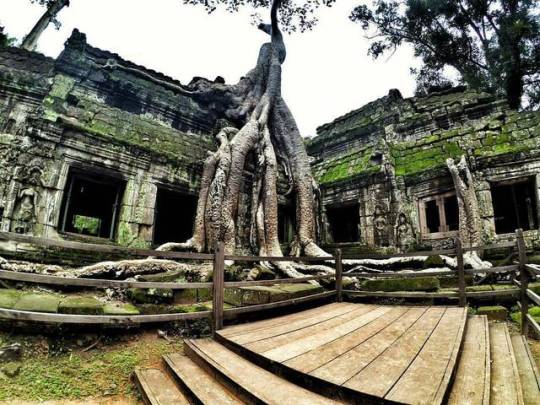
#CambodiaDiaries . Ta Prohm (popularly known as the Tomb Raider temple ) is the modern name of the temple at Angkor, Siem Reap Province, Cambodia, built in the Bayon style largely in the late 12th and early 13th centuries and originally called Rajavihara . . Located approximately one kilometre east of Angkor Thom and on the southern edge of the East Baray, it was founded by the Khmer King Jayavarman VII as a Mahayana Buddhist monastery and university. . Unlike most Angkorian temples, Ta Prohm is in much the same condition in which it was found: the photogenic and atmospheric combination of trees growing out of the ruins and the jungle surroundings have made it one of Angkor's most popular temples with visitors. . . The sight of trees growing within the building was a sight to behold. No wonder it is one of the most popular temple, and is on every travelers radar. . . • 📸✈ @theetlrblog • • • ~~~~~~~~~~~~~~~~~~~~~~~~~~~~~~~~ Tag @theetlrfeed and use #TheETLRfeed #TravelWithETLR to get featured ~~~~~~~~~~~~~~~~~~~~~~~~~~~~~~~~ • Tag someone you would love to go here with. • ~~~~~~~~~~~~~~~~~~~~~~~~~~~~~~~~ . #EatTravelLiveRepeat #cambodia2017 #angkorwat #seasia #siemreap #templerun #tombraider #ETLRTravelDiaries2017 #ig_asia #arountheworld #actioncam #gopro #globetrotter #Nature #TravelDiaries2017 #beautifulcambodia #beautifuldestinations #cambodia (at Ta Prohm)
#traveldiaries2017#nature#angkorwat#seasia#actioncam#tombraider#ig_asia#travelwithetlr#cambodia2017#siemreap#beautifuldestinations#beautifulcambodia#templerun#globetrotter#eattravelliverepeat#theetlrfeed#gopro#arountheworld#cambodiadiaries#cambodia#etlrtraveldiaries2017
0 notes
Photo
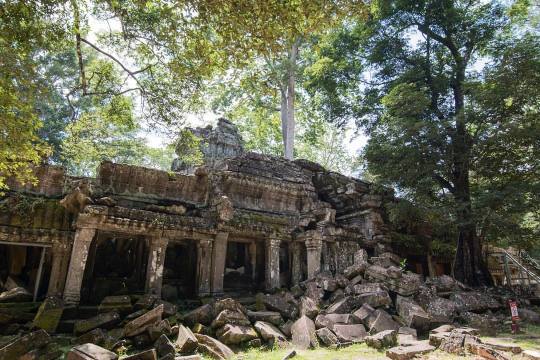
Ta Prohm is the modern name of the temple at Angkor, Siem Reap Province, Cambodia, built in the Bayon style largely in the late 12th and early 13th centuries and originally called Rajavihara (translates to The monastery of King). Located approximately one kilometre east of Angkor Thom and on the southern edge of the East Baray, it was founded by the Khmer King Jayavarman VII as a Mahayana Buddhist monastery and university. The temple's stele records that the site was home to more than 12,500 people (including 18 high priests and 615 dancers), with an additional 800,000 people in the surrounding villages working to provide services and supplies. The stele also notes that the temple amassed considerable riches, including gold, pearls and silks. Expansions and additions to Ta Prohm continued as late as the rule of Srindravarman at the end of the 15th century. Unlike most Angkorian temples, Ta Prohm is in much the same condition in which it was found. The conservation and restoration of Ta Prohm is a partnership project of the Archaeological Survey of India and the APSARA (Authority for the Protection and Management of Angkor and the Region of Siem Reap) #angkor #taprohm #cambodia #siemreap #traveling #travelphotography #travelling #travelasia #travelingram #travelgram #travelporn #nikond5200 #35mmf18 #ruins #temple #cambodia #southeastasia #travelasia (at Ta Prohm)
#nikond5200#travelporn#35mmf18#ruins#cambodia#travelingram#travelphotography#traveling#siemreap#travelgram#taprohm#travelling#travelasia#temple#angkor#southeastasia
0 notes
Photo

A battle between nature and architecture in the Cambodian jungle. 🇰🇭😊📸 Greetings and have a great day all. 🤗 Save, Share and Tag this pic. 💾 I love to hear your comments. ✒ ~~~ Ta Prohm (Khmer: ប្រាសាទតាព្រហ្ម, "Ancestor Brahma") is the modern name of the temple in Siem Reap, Cambodia, built in the Bayon style largely in the late 12th and early 13th centuries and originally called Rajavihara (Khmer: រាជវិហារ, "royal monastery"). Located approximately one kilometre east of Angkor Thom and on the southern edge of the East Baray, it was founded by the Khmer King Jayavarman VII as a Mahayana Buddhist monastery and university. Unlike most Angkorian temples, Ta Prohm is in much the same condition in which it was found: the photogenic and atmospheric combination of trees growing out of the ruins and the jungle surroundings have made it one of Angkor's most popular temples with visitors. UNESCO inscribed Ta Prohm on the World Heritage List in 1992. Today, it is one of the most visited complexes in Cambodia’s Angkor region. The conservation and restoration of Ta Prohm is a partnership project of the Archaeological Survey of India and the APSARA (Authority for the Protection and Management of Angkor and the Region of Siem Reap). . . #asianwanderlust #discoverasia #asiatour #asiatravel #loveasia #seasia #seasiatravel #southeastasiatravel #southeastasiatrip #travelinasia #travelsoutheastasia #visitseasia #visitasia #beautifulcambodia #bestofcambodia #cambodge #cambodiaphotos #cambodiatourism #cambodiatravel #cambodiatrip #cambodia🇰🇭 #camboya #explorecambodia #ig_cambodia #igerscambodia #kambodscha #kingdomofwonder #travelcambodia #visitcambodia #worldwithoutborders (at Ta Prohm) https://www.instagram.com/p/CSJBjwKMYd2/?utm_medium=tumblr
#asianwanderlust#discoverasia#asiatour#asiatravel#loveasia#seasia#seasiatravel#southeastasiatravel#southeastasiatrip#travelinasia#travelsoutheastasia#visitseasia#visitasia#beautifulcambodia#bestofcambodia#cambodge#cambodiaphotos#cambodiatourism#cambodiatravel#cambodiatrip#cambodia🇰🇭#camboya#explorecambodia#ig_cambodia#igerscambodia#kambodscha#kingdomofwonder#travelcambodia#visitcambodia#worldwithoutborders
0 notes
Photo
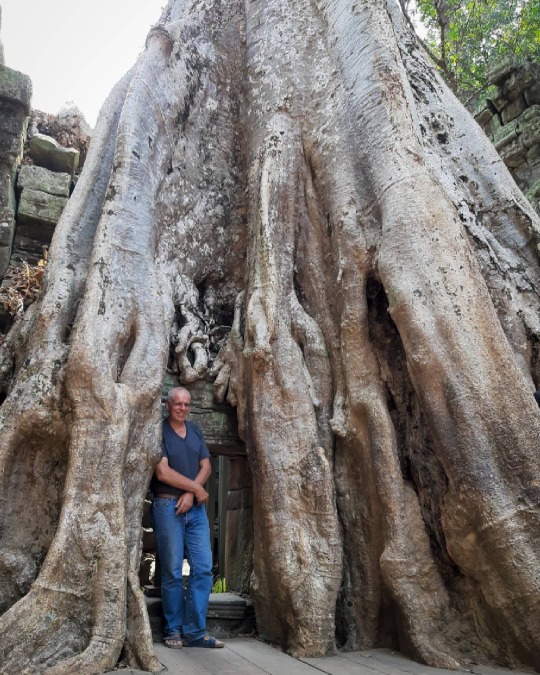
It seems that no matter how hard we try to create something, nature always finds a way to take it all back. 📸😊🇰🇭 Ta Prohm (Khmer: ប្រាសាទតាព្រហ្ម, "Ancestor Brahma") is the modern name of the temple in Siem Reap, Cambodia, built in the Bayon style largely in the late 12th and early 13th centuries and originally called Rajavihara (Khmer: រាជវិហារ, "royal monastery"). Located approximately one kilometre east of Angkor Thom and on the southern edge of the East Baray, it was founded by the Khmer King Jayavarman VII as a Mahayana Buddhist monastery and university. Unlike most Angkorian temples, Ta Prohm is in much the same condition in which it was found: the photogenic and atmospheric combination of trees growing out of the ruins and the jungle surroundings have made it one of Angkor's most popular temples with visitors. UNESCO inscribed Ta Prohm on the World Heritage List in 1992. Today, it is one of the most visited complexes in Cambodia’s Angkor region. The conservation and restoration of Ta Prohm is a partnership project of the Archaeological Survey of India and the APSARA (Authority for the Protection and Management of Angkor and the Region of Siem Reap). . . #asiatour#asiatravel#loveasia #seasia#seasiaig #seasiatravel#southeastasiatravel#southeastasiatrip#thisisasia#travelinasia#travelsoutheastasia#visitseasia#visitasia#beautifulcambodia#bestofcambodia#cambodge#cambodiaphotos#cambodiatourism#cambodiatravel#cambodiatrip#cambodia🇰🇭#camboya#explorecambodia#ig_cambodia#igerscambodia#kambodscha#kingdomofwonder#travelcambodia#visitcambodia#angkortemples (at Ta Prohm) https://www.instagram.com/p/CPIisdnsuI0/?utm_medium=tumblr
#asiatour#asiatravel#loveasia#seasia#seasiaig#seasiatravel#southeastasiatravel#southeastasiatrip#thisisasia#travelinasia#travelsoutheastasia#visitseasia#visitasia#beautifulcambodia#bestofcambodia#cambodge#cambodiaphotos#cambodiatourism#cambodiatravel#cambodiatrip#cambodia🇰🇭#camboya#explorecambodia#ig_cambodia#igerscambodia#kambodscha#kingdomofwonder#travelcambodia#visitcambodia#angkortemples
0 notes
Photo

The hidden Buddha of Ta Prohm Temple, Angkor, Cambodia 🙏😊🇰🇭 Greetings and have a great day all. 🤗 Save, Share and Tag this pic. 💾 I love to hear your comments. ✒ ~~~~ Ta Prohm (Khmer: ប្រាសាទតាព្រហ្ម, "Ancestor Brahma") is the modern name of the temple in Siem Reap, Cambodia, built in the Bayon style largely in the late 12th and early 13th centuries and originally called Rajavihara (Khmer: រាជវិហារ, "royal monastery"). Located approximately one kilometre east of Angkor Thom and on the southern edge of the East Baray, it was founded by the Khmer King Jayavarman VII as a Mahayana Buddhist monastery and university. Unlike most Angkorian temples, Ta Prohm is in much the same condition in which it was found: the photogenic and atmospheric combination of trees growing out of the ruins and the jungle surroundings have made it one of Angkor's most popular temples with visitors. UNESCO inscribed Ta Prohm on the World Heritage List in 1992. Today, it is one of the most visited complexes in Cambodia’s Angkor region. The conservation and restoration of Ta Prohm is a partnership project of the Archaeological Survey of India and the APSARA (Authority for the Protection and Management of Angkor and the Region of Siem Reap). . . . #beautifulcambodia#bestofcambodia#cambodge#cambodiaphotos#cambodiatourism#cambodiatravel#cambodiatrip#cambodia🇰🇭#camboya#explorecambodia#ig_cambodia#igerscambodia#kambodscha#khmerempire#kingdomofwonder#travelcambodia#visitcambodia#angkortemples #khmerempire #taprohm #mustdotravels#mustvisitplaces#passporttoearth#instatravelers#reiseliebe#createxplore#globalwanderer#stillatraveler#thetravellingnomads#wandertheworld (at Ta Prohm) https://www.instagram.com/p/COfCH5zM8Ko/?igshid=14xcm211s9bi3
#beautifulcambodia#bestofcambodia#cambodge#cambodiaphotos#cambodiatourism#cambodiatravel#cambodiatrip#cambodia🇰🇭#camboya#explorecambodia#ig_cambodia#igerscambodia#kambodscha#khmerempire#kingdomofwonder#travelcambodia#visitcambodia#angkortemples#taprohm#mustdotravels#mustvisitplaces#passporttoearth#instatravelers#reiseliebe#createxplore#globalwanderer#stillatraveler#thetravellingnomads#wandertheworld
0 notes